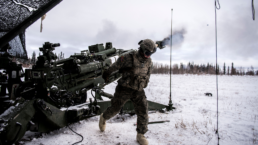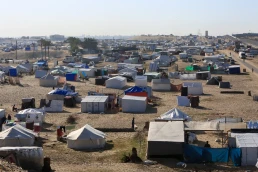Amid rising geopolitical tensions, the U.S. is expanding its military presence in Greenland, increasing the risk of something going very wrong.
by Adam Federman, In These Times
In the spring of 1953, when Regina Kristiansen was 14, she and her family were forced to leave their village of Uummannaq in northwestern Greenland, hundreds of miles above the Arctic Circle. At the behest of Danish authorities, who promised them new homes, they were given just a few days to gather their belongings. Kristiansen drove a dogsled across the ice for two days before reaching a barren island in Baffin Bay. Along with seven other families, they lived in makeshift tents for months as storms lashed the shore and winter approached. One woman gave birth in the tents. Another, a village elder, died before Denmark finished building their homes.
Altogether, 116 people from 26 families left Uummannaq, and their homes were burned to the ground. At the time, the Danish government — then a waning colonial power — characterized the move as voluntary. But in fact, the families were evicted to allow for the expansion of a U.S. Air Force base called Thule. The 233,000-acre base and deepwater port is one of the largest U.S. military installations in the world, and it played a prominent role in North American missile defense during the Cold War. It has also been a source of some of the U.S. military’s most closely held secrets.

Originally built following a 1951 bilateral defense agreement with Denmark — which granted the United States broad authority to operate on the island — Thule became the staging ground for a U.S. nuclear weapons program that was kept hidden from Greenland’s people. A missile launch facility, code-named “Project Iceworm,” was built deep under the ice sheet east of Thule, and, in 1968, a B-52 bomber carrying four thermonuclear bombs crashed a few miles from what had been Uummannaq. At one point, America had 17 military installations in Greenland, reflecting the Pentagon’s long-held view of the country as the “world’s largest stationary aircraft carrier.”
Recent Posts
Why Are Democratic Lawmakers Still Meeting With Netanyahu?
July 12, 2025
Take Action Now Pictures show Democrats like Chuck Schumer standing next to Netanyahu, smiling.By Sharon Zhang, Truthout A bipartisan group of…
Stop Israel’s Dystopian “Humanitarian City” Plan—Before It’s Too Late
July 11, 2025
Take Action Now For the past 20 months, the world has watched—and largely enabled—a genocidal campaign in Gaza. Over 55,000 Palestinians have been…
The “Liberal” International Order Is Criminalizing Palestine Protests
July 11, 2025
Take Action Now As Western governments repress Palestine solidarity and enable Israel’s impunity, the “liberal international order” is no longer…
Politicians Are Betraying Gen Z On Climate
July 10, 2025
Take Action Now While Gen-Zers thrift, knit, crochet, and find other ways to reduce our footprints, Trump and the GOP are greenlighting more climate…




